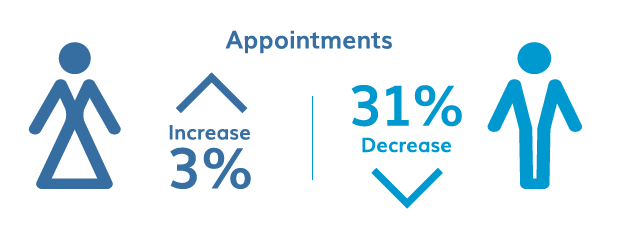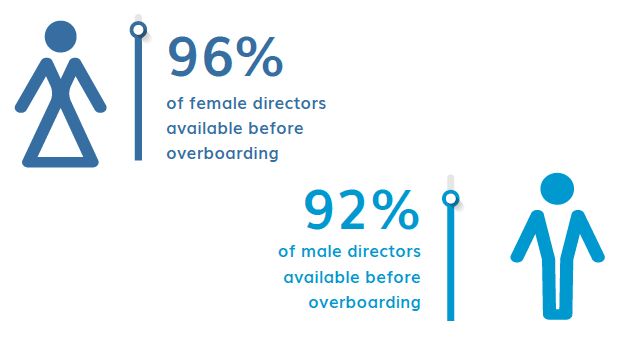Corporate boards are responding to legal, societal, and shareholder demands for more gender diversity. In 2018, a third of new board appointments were women, according to a report by CGLytics titled, Increasing Boardroom Diversity: S&P 500 Review (published Feb. 2019). Female appointments rose by 3% while appointments of males fell by 31%.

Yet heightened representation ironically brings with it an argument against more women directors. As women earn seats on multiple boards, do these governance professionals run the risk of being 'overboarded'?
Overboarding is a valid concern, particularly as boards grow in size and board member responsibilities become more complex. A board member's job is demanding, requiring abundant time, energy, and skills. In such an environment, an overboarded director risks being 'spread too thinly,' in the words of CGLytics, with insufficient time and resources to devote to the company and their role. In fact, proxy advisors recommend that governance professionals vote against the directors and executives they consider to be overboarded.
But is overboarding a valid excuse for not recruiting a woman for an open position? Are there really so few women directors out there that the available ones risk juggling too many commitments? Let's look at the numbers.
A potential pool of thousands
Thanks to a deep pool of candidates, boards recruiting female directors have a long way to go before overload becomes a concern, according to the CGLytics analysis. CGLytics used US Proxy Advisor standards to assess the number of current female board members who were eligible for other board appointments before being considered 'overboarded.' On S&P 500 boards, CGLytics founds that there are 1,329 female directors currently eligible for additional board appointments; an additional 1,227 eligible female directors serving on Mid Cap 400 and Small Cap 600 boards.

These figures are encouraging when you look at the numbers of board appointments needed to close corporate governance's gender gap: 327 female appointments needed to reach gender diversity goal of 30%, and 1,431 female appointees to reach full gender parity.
What does this look like for a specific industry? CGLytics' numbers follow for how many female directors can be recruited before overboarding becomes a concern:
 Most industries reported an increase in the number of women on their boards. Those which recorded a decrease, telecommunications services and materials, have significantly fewer female directors available for recruitment.
Most industries reported an increase in the number of women on their boards. Those which recorded a decrease, telecommunications services and materials, have significantly fewer female directors available for recruitment.
1,329 women currently sit on S&P 500 company boards'but 2,577 candidates are available if the net is cast wider.
' CGLytics' S&P 500 Review: Increasing Board Diversity
The goal of this analysis is not to suggest that all non-executive females should serve on five boards; rather, CGLytics is demonstrating that the 'overboarding' argument fails to hold water when 96% of existing female directors fall below US Proxy Advisor standards. And their analysis only considers women who are currently serving on boards...Imagine how the pool grows when boards consider female candidates without existing public company board experience.
Identifying high-value candidates
Casting a wider net is not simply a diversity initiative. It's what today's boards need to do to maintain a competitive advantage. As more companies undergo market disruption and business-model transformation, boards need to consider candidates outside of the traditional mold to contribute those perspectives. Diligent, along with search firm Spencer Stuart, hosts a group of 'next generation' directors called the Next Gen Board Leaders. Among this diverse group of young corporate directors are skill sets ranging from cybersecurity to digital marketing to business transformation expertise.
Ongoing planning is important. It's not just, 'wake up, we need a new director.' ' Paula Loop, Leader, PwC's Governance Insights Center
Boards must ensure they have the right technology at their fingertips enabling them to evaluate the current talent pool, judge supply and demand, and identify applicable prospects, even among the most difficult-to-reach C-level executives. Diligent's Nomination & Governance module allows board to evaluate their composition in areas from gender diversity to overboarding, and see how they compare to peers. Search candidates by experience, demographics, region, sector, and discipline, then look into overlapping directorships, seats on competing boards, mutual connections, and more.
|
Boards must ensure they have the right technology at their fingertips enabling them to evaluate the current talent poo l, judge supply and demand, and identify applicable prospects, even among the most difficult-to-reach C-level executives. Diligent's Nomination & Governance module allows board to evaluate their composition in areas from gender diversity to overboarding, and see how they compare to peers. Search candidates by experience, demographics, region, sector, and discipline, then look into overlapping directorships, seats on competing boards, mutual connections, and more. |
 |
In the words of the CGLytics report: 'Not recruiting female candidates due to alleged overboarding concerns proves to be an untenable excuse for companies to defend a lack of gender diversity.'





